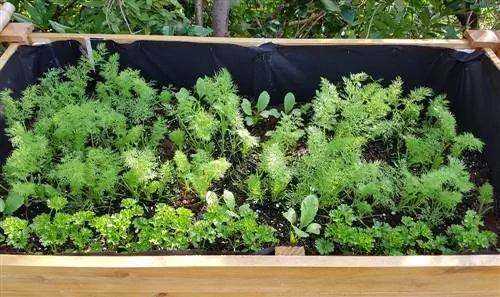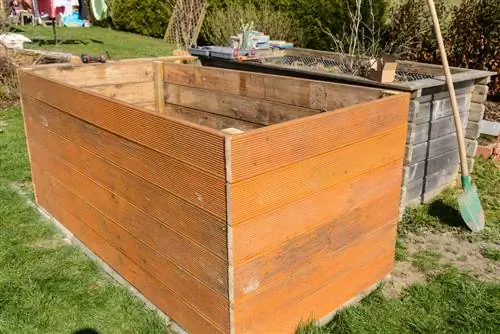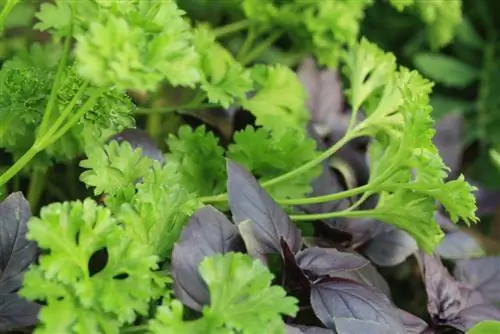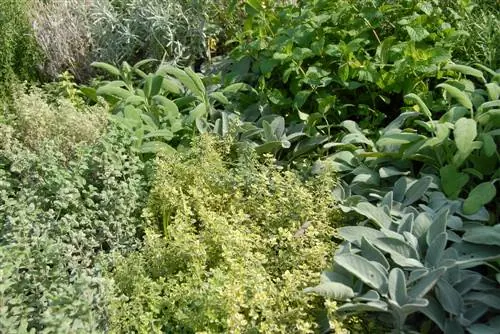- Author admin [email protected].
- Public 2023-12-16 16:46.
- Last modified 2025-01-23 11:21.
Fresh herbs from the garden are he althy, have an incomparable aroma and are also extremely decorative. They are also easy to cultivate. If you want to create a raised bed with only herbs, it is best to choose species and varieties that have roughly the same requirements for the location.
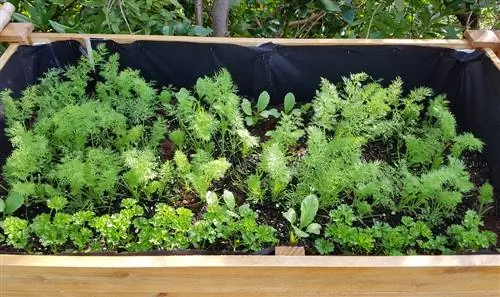
Which herbs are suitable for a raised bed?
A raised herb bed offers a selection of sun-loving plants such as basil, rosemary and thyme and partial shade-tolerant herbs such as wild garlic, parsley and chives. Care for your herbs with annual composting, regular watering and, if necessary, pruning for compact growth.
Suitable herbs for a raised kitchen herb bed
Many of the typical culinary herbs are real sun worshipers who particularly enjoy a place in full sun. Of course, there is a large selection of species that thrive in partial shade as well as quite uncomplicated species that thrive in both sunny and partially shaded places.
Herbs for a sunny location
These species, which are often used in the kitchen, are particularly suitable for a raised herb bed in the sun:
- Anise (Pimpinella anisum)
- Basil (Ocimum basilicum)
- Curry herb (Helichrysum italicum)
- Dill, cucumber herb (Anethum graveolens)
- Tarragon (Artemisia dracunculus)
- Fennel (Foeniculum vulgare)
- Chamomile (Matricaria chamomilla)
- Caraway (Carum carvi)
- Marjoram (Origanum majorana)
- Pimpinelle, small meadow button (Sanguisorba minor)
- Tripmadam, rock stonecrop or stonecrop (Sedum rupestre)
- Wormwood, bitter mugwort (Artemisia absinthium)
- Lemon verbena, lemon bush (Aloysia citrodora)
Furthermore, the typical Mediterranean herbs such as rosemary, thyme, lavender, oregano and sage also belong to the group of sun worshipers.
Herbs for partial shade
Even if you only have a location in partial shade, you don't have to go without a large selection of different types of herbs. By the way, these can be wonderfully combined with all kinds of kitchen vegetables such as onions, leeks, garlic, etc.
- Wild garlic (Allium ursinum)
- Savory (Satureja hortensis)
- Borage (Borago officinalis)
- Tarragon (Artemisia dracunculus)
- Garden cress (Lepidium sativum)
- Chervil (Anthriscus cerefolium)
- Garlic mustard (Alliaria petiolata)
- lovage, maggi herb (Levisticum officinale)
- Melissa, lemon balm (Melissa officinalis)
- Parsley (Petroselinum crispum)
- Arugula (Eruca sativa)
- Chives (Allium schoenoprasum)
- Woodruff (Galium odoratum)
- Lemongrass, Lemongrass (Cymbopogon citratus)
Properly care for herbs in raised beds
Culinary and medicinal herbs are quite undemanding and usually thrive on their own. Adding compost in the spring is usually sufficient to provide nutrients. You should also not forget to water in dry times. Perennial species, provided they are hardy, receive a fleece cover in November (€49.00 at Amazon). This is intended to protect them from drying out and cold. Woody herbs such as thyme, lavender and sage will remain compact if you cut them back by about a third in the spring.
The Mediterranean raised herb bed
Mediterranean herbs feel particularly comfortable in a raised bed with lean, well-drained soil and in a warm and sunny location. They go well with Mediterranean vegetables - then you have the most important ingredients for a ratatouille or a self-mixed bouquet of Herbes de Provence at hand. For example, they fit very well together in the raised bed:
- Eggplant, eggplant (Solanum melongena)
- Basil (Ocimum basilicum)
- Garlic (Allium sativum)
- Lavender (Lavandula angustifolia)
- Oregano (Origanum vulgare)
- Pepperoni (Capsicum annuum)
- Rosemary (Rosmarinus officinalis)
- Sage (Salvia officinalis)
- Thyme (Thymus vulgaris)
You can also plant low-growing tomato plants and zucchini in the bed - but be careful: In contrast to the Mediterranean herbs, these are real heavy feeders and need a lot of nutrients.
Tip
If you like drinking herbal tea, you can grow typical tea herbs such as lavender, lemon balm, sage, mint, fennel, anise, caraway, thyme, lemon verbena and sweet herb (stevia) in your raised bed.


